|
PAGE
2 CONTINUED
FROM PAGE 1
AVONLEA
POINTS
EARLY
NORTHERN HIGH PLAINS ARROWHEADS
MONTANA
A.D. 210 TO
A.D. 800
PAGE 2 OF 2 PAGES
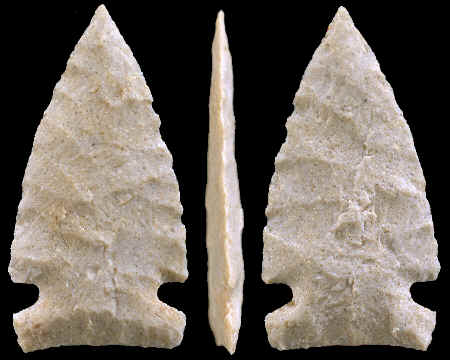
CLICK ON
PICTURE FOR LARGE TRIPLE IMAGE
AVONLEA
POINT
BISON KILL
SITE NEAR CONRAD,
MONTANA
EARLY LATE PREHISTORIC PERIOD
NORTHWESTERN PLAINS
ELMER A.
GUERRI COLLECTION
This Avonlea point is very well made and represents an ideal example
for the type. This point exhibits fine pressure flaking and is fairly
thin. The base is slightly concave, the side-notches are
"u" shaped and close to the base and the blade edges
are convex. This point measures 1 3/16 inches (3 cm) long.
|
|
|
H.P. Lewis sifted hundreds of Avonlea points from the ravine near Conrad,
Montana. The 65 Avonlea points pictured in this article represent the
best examples out of 140 that were once in a frame put together by Professor Lewis.
An old tag applied to the back explains that he put together a
large number of these frames for display at the school in Conrad,
Montana.
|
|
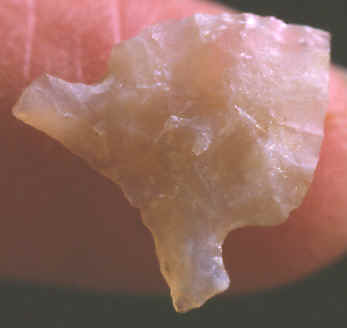
CLICK ON
PICTURE FOR LARGE TRIPLE IMAGE
AVONLEA POINT
BISON KILL
SITE NEAR CONRAD,
MONTANA
EARLY LATE PREHISTORIC PERIOD
NORTHWESTERN PLAINS
ELMER A.
GUERRI COLLECTION
This Avonlea point was extensively resharpened one or more times. If
it had received any more damage it would have been discarded. This
point measures 11/16 of an inch (1.7 cm) long. |
|
|
Avonlea points are described as small side notched arrow points.
They are triangular in outline with either straight or convex
cutting edges. The notches are either u-shaped or v-shaped and placed close to the base. The base (hafting area) is
usually concave but they can also be straight.
|
|
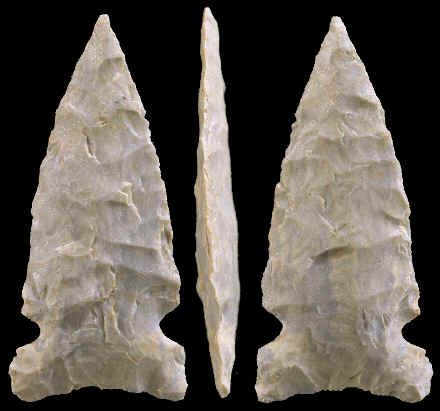
CLICK ON
PICTURE FOR LARGE TRIPLE IMAGE
AVONLEA POINT
BISON KILL
SITE NEAR CONRAD,
MONTANA
EARLY LATE PREHISTORIC PERIOD
NORTHWESTERN PLAINS
ELMER A.
GUERRI COLLECTION
This Avonlea point fits within the descriptive parameters set for these small side-notched points.
This one is triangular in outline, it has a wide concave base with
"U" shaped side-notches that are close to the base and it
was skillfully made with nicely done pressure flaking. It measures 1
5/16 inches (3.3 cm) long. |
|
|
Like most projectile points, Avonlea points have some variation in
style. There is a "classic" ideal example that is called
Avonlea but there is also a range of variations within the type example
that is still accepted as Avonlea. Some Avonlea points will have deeper
concave bases than others and a few might even have
straight base, etc., etc. These variations from the "classic" type
example can happen for different reasons. Damaged Avonlea points were
sometimes considerably altered by resharpening. They were also
manufactured by many different individuals of
different age and skill levels and by different
small social groups.
|
|
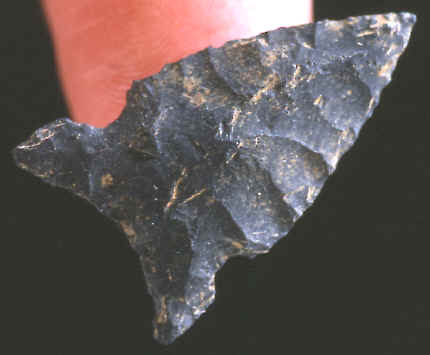
AVONLEA
POINT
BISON KILL
SITE NEAR CONRAD,
MONTANA
EARLY LATE PREHISTORIC PERIOD
NORTHWESTERN PLAINS
ELMER A.
GUERRI COLLECTION
This is a typical example. It has a wide concave base, "u"
shaped side-notches that are close to the base and pressure flaking
that is fairly well done. |
|
|
Thomas F. Kehoe describes four different sub-types of the Avonlea
point. The "standard Avonlea point" has a straight to
convex sided blade with "u" or "v" shaped
side-notches close to the base plus a wide concave base. The
"Gull Lake" variety has the classic Avonlea form but is
thinner and lighter in weight. The "Carmichael Wide
Eared" variety is shorter and narrower and heavier in
cross-section. The "Timber Ridge Sharp-Eared" variety is
widest at the base along with a fairly straight base and sharp
basal corners.
|
|
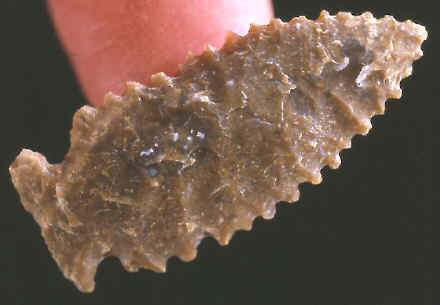
AVONLEA
POINT (Eccentric?)
BISON KILL
SITE NEAR CONRAD,
MONTANA
EARLY LATE PREHISTORIC PERIOD
NORTHWESTERN PLAINS
ELMER A.
GUERRI COLLECTION
This serrated example was evidently excavated by Professor Lewis
along with all the other points pictured in this article. It doesn't
fit within accepted descriptions for Avonlea points but it could be
an individuals variation on the point type. Another example of this
could be drawn from the 11,000 year old Mill Iron bison kill site in
Montana. All the points found there were Goshen points of various
forms. But one example was very different in that it was very much
thinner that the others, it was pressure flaked much better than the
other examples and instead of a sharp point the tip was
"rounded" with very fine pressure flaking that was
deliberate. In-other-words it was an oddity that stood out but it's still
considered a Goshen point. |
|
|
Avonlea
points are important early markers in the Northwestern High Plains, when
they can be correctly identified. They were made by people who were communally hunting bison with bows and
arrows and killing them at close range in natural corral-like land
forms. The Avonlea point hunters were living off what at the time was
some of the largest animals in all of North America. They were continuing
an 11,000 year old tradition of big game hunting on the High Plains. A
tradition that would last about one and a half thousand years into the
future.
|
|
"REFERENCES"
1985,
"Selected Preforms, Points and Knives of the North American
Indians," Vol. I, by Gregory Perino, p.23.
1988, "Avonlea Yesterday and Today," A Plains Conference
Symposium, by Leslie B. Davis, PhD., pp. 5-11.
1999, "Prehistoric American," No. 3, 1999, "Some Point
Types From the Northern High Plains," by John Grenawalt, p. 9.
|
|
HOME
ORDERING |




